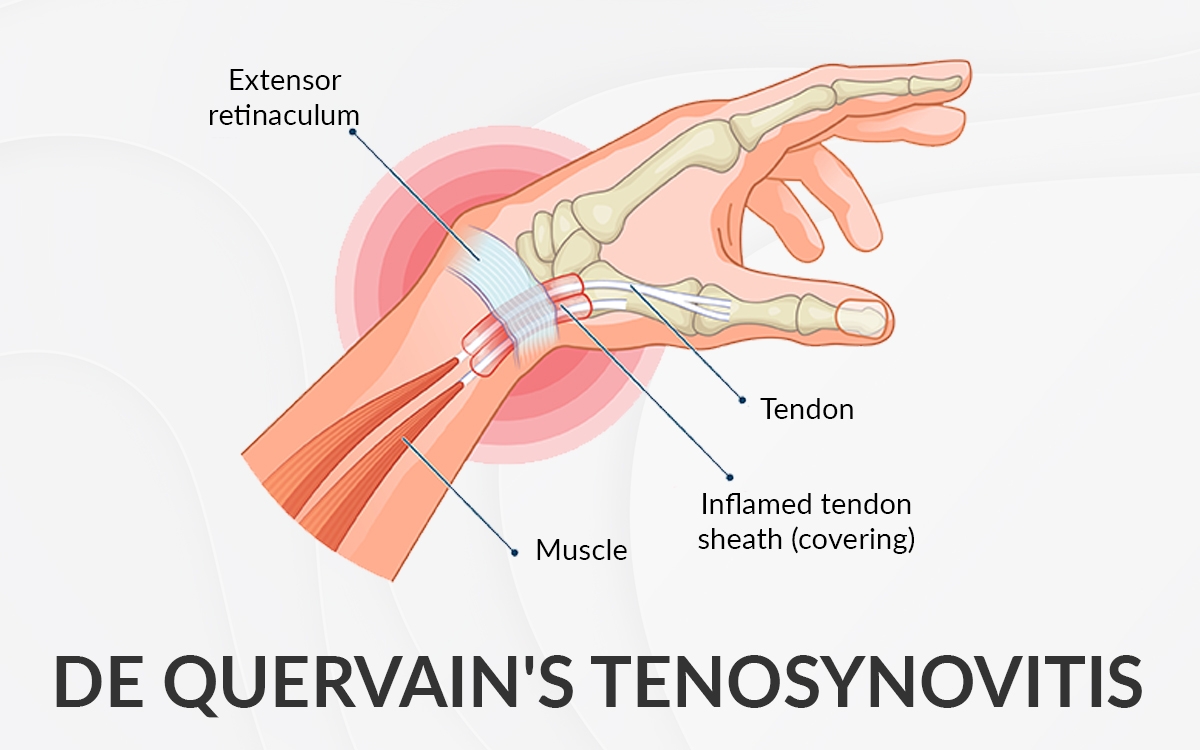
Summary
Symptoms
Pain, tenderness and swelling on the thumb side of the wrist.
Causes
- Repetitive thumb movements
- Overuse of the wrist and thumb
Diagnosis
Finkelstein test
Treatment
- Using the splint
- Ultrasound guided steroid injection
- Activity modification
- Severe cases may require surgery
Details of surgery
- Day care procedure
- General anaesthesia
- Lasts roughly 30-45 minutes
What is De Quervain’s Disease?
It is a painful wrist condition which happens because of compression of the tendons in the tunnel on the thumb side of the wrist. (Tendons are cord like structures which join a muscle to the bone).
This is caused by inflammation and thickening of the sheath which contains these tendons. This will cause swelling and pain on attempted thumb and wrist movements.
The main cause is repetitive thumb movements (repetitive strain injury). Other associations with this disease are pregnancy, post trauma, diabetes, rheumatoid arthritis and osteoarthritis etc.
What are the symptoms and causes of De Quervain’s Syndrome?
Symptoms – It is usually characterised by pain, tenderness and swelling on the thumb side of the wrist.
Causes – It is caused by repetitive thumb movements and overuse of the wrist and thumb for example, constant gripping, wringing out sponges, repetitive typing, lifting, organising files in office, playing a musical instrument for hours at a time or lifting an infant awkwardly etc.
How is it diagnosed?
It is done using a simple test called Finkelstein test. Essentially your surgeon will grasp your thumb and deviate the wrist in an ulnar fashion (bend your wrist towards your little finger) and if you have De Quervain’s disease you will feel a lot of pain on the thumb side of the wrist. We will also assess thickening, swelling and tenderness on the thumb side of the wrist.
How is it treated?
In mild cases it can be managed using the splint, ultrasound guided steroid injection and activity modification. So idea is to balance activity with adequate periods of rest; break your daily tasks into small components to allow muscles and tendons to take rest. When you notice pain, stop what you are doing and take a rest. To avoid repetitive movements such as wringing, twisting and lifting heavy objects.
Discuss with your hand therapist the possible tools to reduce the stress on your wrist and thumb. Cold application and anti- inflammation medicines will help.
If symptoms do not settle or in more severe cases you will be offered a surgical release.
What does the operation involve?
The operation is done as a day case procedure under a general anaesthetic. A small cut is made on the thumb side of the wrist and the tight tendon sheath is released to allow free movements of the tendons. The operation takes roughly 30-45 minutes.
What happens after the surgery?
Most patients are sent home the same day with pain killers.
The pressure bandage is reduced in two to three days. You will be given spare dressings to take home and you will have to keep the wound dry for two weeks.
You will be advised to keep your hand rested and elevated and you will be shown finger and wrist exercises.
You will be seen back in clinic in two weeks’ time for a wound check and removal of sutures where further hand therapy, post op rehabilitation will be advised.
What are the risks of surgery?
On the whole results of surgery are excellent. The risks are very small and include infection, damage to the sensory branch of the nerve which can lead to a patch of numbness on the thumb side of the wrist, stiffness to the thumb, tenderness to the scar, recurrence, tendon instability/snapping and complex regional pain syndrome.
BMI Chelsfield Park Hospital
Bucks Cross Road Chelsfield ORPINGTON BR6 7RG
01689 877855
BMI The Blackheath Hospital
40-42 Lee Terrace Blackheath LONDON SE3 9UD
020 8318 7722
BMI The Sloane Hospital
125 Albemarle Road BECKENHAM BR3 5HS
020 8466 4000
Princess Royal University Hospital
Farnborough Common ORPINGTON BR6 8ND
01689 863223



